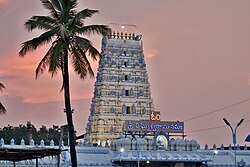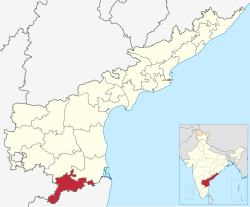|
Chittoor district
Chittoor district (ⓘ) is one of the eight districts in the Rayalaseema region of the Indian state of Andhra Pradesh. It had a population of 18,72,951 at the 2011 census of India.[8] It is a major market centre for mangoes, grains, sugarcane, and peanuts. The district headquarters is at Chittoor City. The major cities/towns in the district are Chittoor, Punganur, Nagari, Palamaner, and Kuppam. EtymologyThe district derived its name from its headquarters Chittoor.[9] HistoryAfter the Indian independence in 1947, Chittoor region became a part of the erstwhile Madras state. The modern Chittoor district was formerly Arcot District, which was established by the British in the 19th century. It had Chittoor as its headquarters. Chittoor district was constituted on 1 April 1911 with the taluks of Chittoor, Palamaner, and Chandragiri from Old North Arcot district of Tamilnadu, Madanapalle and Voyalpadu Taluks of Kadapa district and Ex-Zamindari areas of Pileru, Punganur, Srikalahasthi, Puttur and Old Karvetinagar estate. As a result of Pataskar Award consequent on the re-organisation of the state on a linguistic basis on 1 April 1960, a major portion of Tiruthani taluk was transferred to Chengalpattu district of Tamilnadu in exchange for one taluk known as Sathyavedu comprising 186 villages from Tamilnadu. Also from the same date, 220 villages from Palamaner Taluk and Three villages from Krishnagiri Taluk of Salem District of Tamilnadu were transferred to form Kuppam Sub-Taluk and 145 villages from Chittoor Taluk were transferred to form Bangarupalem Sub-Taluk. Subsequently, Kuppam and Bangarupalem were made full-fledged taluks. The district was organised into 66 revenue mandals in 1985.[10][11] Again the District Re-organised with 31 Mandals and 4 Revenue Divisions on 4 April 2022. Annamayya district and Tirupati district were formed from parts of the erstwhile Chittoor district and others.[12] This has resulted in the district becoming primarily rural and losing central educational institutes and health infrastructure.[13] Demographics
According to the 2011 census, Chittoor district prior to restructuring in 2022 had a population of 4,174,064.[15][16][17] This gives it a ranking of 47th in India (out of a total of 640) and 6th in its state.[15] The district has a population density of 275 inhabitants per square kilometre (710/sq mi).[15] Its population growth rate over the decade 2001–2011 was 11.33%.[15] Chittoor has a sex ratio of 1002 females for every 1000 males, and a literacy rate of 72.36%.[15] EconomyThe Gross District Domestic Product (GDDP) of the undivided district for FY 2013-14 is ₹34,742 crore (US$4.0 billion) and it contributes 6.6% to the Gross State Domestic Product (GSDP). For the FY 2013–14, the per capita income at current prices was ₹64,671 (US$750). The primary, secondary and tertiary sectors of the district contribute ₹8,226 crore (US$950 million), and ₹18,849 crore (US$2.2 billion) respectively.[18] The major products contributing to the GVA of the district from agriculture and allied services are, sugarcane, groundnut, tomato, mango, milk, meat and fisheries. The GVA to the industrial and service sector is contributed from construction, electricity, manufacturing, education and ownership of dwellings.[18] Hydrology and climateThe important rivers in the district before restructuring were Ponnai and Swarnamukhi, which originate in the Eastern Ghats. Other rivers include Araniyar, Bahuda, Beema, Cheyyeru, Kalangi, Kalyani, Koundinya, Kusasthali, Neeva, Papaghni, Pileru, Pincha, and Pedderu. None of the rivers are perennial. The temperature in the western parts of the undivided district like Pileru, Punganur, Madanapalle, Horsley Hills are relatively lower than the eastern parts of the Chittoor District. This is because of the higher altitude of the western parts compared to the eastern parts. The summer temperature touches 44 °C in the eastern parts whereas in the western parts, it ranges around 36 ° to 38 °C. Similarly, the winter temperatures of the western parts are relatively low ranging from 12 °C to 14 °C, and in eastern parts it is 16 °C to 18 °C. Most of the district has a Tropical wet and dry climate, with some north-western parts having Hot semi-arid climate.[19] Undivided Chittoor district receives an annual rainfall of 918.1 mm. The South West Monsoon and North East Monsoon are the major sources of rainfall for the district. On average the district receives 438.0 mm of rainfall through the South West Monsoon (From June to September) and 396.0 mm from North East Monsoon (From October to December). The rainfall received by the district in the years 2002 and 2003 were 984.2 mm and 934 mm respectively.[20] GeographyChittoor is a part of Rayalaseema region of Andhra Pradesh.[21] The district occupies an area of 6,855 square kilometres (2,647 sq mi).[22][23] This district is also under Tondai Nadu Region. The district is bounded by Annamayya district to the North, Krishnagiri District, Tirupattur District, Vellore District and Tiruvallur District of Tamil Nadu state to the South, Tirupati district to the East & North, Kolar District of Karnataka state to the West. The district is located between the northern latitudes of 12°-44’-42″ and 13°-39’-21″ and between the eastern longitudes 78°-2’-2″ and 79°-41’-52″. Chittoor, the district headquarters is 150 km from Chennai, 165 km from Bangalore.[24] ClimateChitoor has been ranked 21st best “National Clean Air City” under (Category 3 population under 3 lakhs cities) in India.[25] DemographicsAfter reorganisation, the district had a population of 18,72,951, of which 368,644 (19.68%) lived in urban areas. Chittoor district has a sex ratio of 993 females per 1000 males. Scheduled Castes and Scheduled Tribes made up 3,94,327 (21.05%) and 51,574 (2.75%) of the population respectively.[15]: 82–87 Based on the 2011 census, 73.23% of the population spoke Telugu, 16.75% Tamil and 8.72% Urdu as their first language.[4] Telugu is the primary official language of the district along with English. Tamil is widely spoken in the border areas, especially in Kuppam.[27] Administrative divisions The district is divided into four revenue divisions: Chittoor, Kuppam, Nagari and Palamaner, which are further subdivided into a total of 32 mandals, each headed by a sub-collector.[28][29] MandalsThe list of 32 mandals in Chittoor district, is given below.[30] Cities and townsChittoor is a Municipal Corporation, while Kuppam, Punganur, Palamaner and Nagari are municipalities.[2]: 19, 21, 58
Villages
PoliticsThere are two parliamentary and seven assembly constituencies located in this district. The parliamentary constituencies are Chittoor (Lok Sabha constituency) and Rajampet Lok Sabha constituency(partial). The assembly constituencies are given below.[33]
Economy Agriculture and horticulture are the mainstays of the district's economy. TransportRoadwaysNH 69 and NH 40 pass through the district.[34] Six lane expressway connecting Tirupati and Bangalore via Chittoor is operational.[35] NH 42, a two lane Highway from Anantapur-Kuppam-Krishnagiri passes through the District. RailwaysChittoor District has two major railway stations.
AirportsNearest airports Tirupati Airport at a distance of 86Km from Chittoor Kuppam Airport at a distance of 120Km from Chittoor EducationDravidian University is the only university in the district after the reorganisation.[13] Tourism 
Notable peopleV. Nagayya, also known as Chittoor Nagayya, was brought up in Kuppam. He was a pioneering Indian actor, singer, music composer, and director in the Telugu and Tamil film industry. Cattamanchi Ramalinga Reddy was born in Kattamanchi, a suburb of Chittoor. He was an educationist, economist, poet and literary critic. Prathap Chandra Reddy, born in Aragonda, is a cardiologist who founded the first corporate chain of hospitals in India, the Apollo Hospitals. References
External links |
|||||||||||||||||||||||||||||||||||||||||||||||||||||||||||||||||||||||||||||||||||||||||||||||||||||||||||||||||||||||||||||||||||||||||||||||||||||||||||||||||


